Southern Cross University: MNG00785 Project Management Task 2 Report
VerifiedAdded on 2023/03/21
|6
|1474
|44
Report
AI Summary
This report provides an overview of project management, including the initiation, planning, execution, control, and closure phases. It highlights the importance of each stage, emphasizing the critical role of planning in determining project timelines, resource allocation, and risk assessment. The report also discusses the execution phase, focusing on progressive reporting and the use of Key Performance Indicators (KPIs) to maintain control. The closure phase involves assessing the project's effectiveness against stakeholder expectations. The document includes references to various project management resources and appears to include sections relating to a practical task, possibly Assessment Task 2 from MNG00785 – Project Management at Southern Cross University, covering elements such as WBS, RACI charts, Gantt charts, AON charts, resource management, budgeting, progress reporting, risk management, change management and stakeholder communication.

Running Header: PROJECT MANAGEMENT 1
Project management
Name
Institutional affiliation.
Project management
Name
Institutional affiliation.
Paraphrase This Document
Need a fresh take? Get an instant paraphrase of this document with our AI Paraphraser
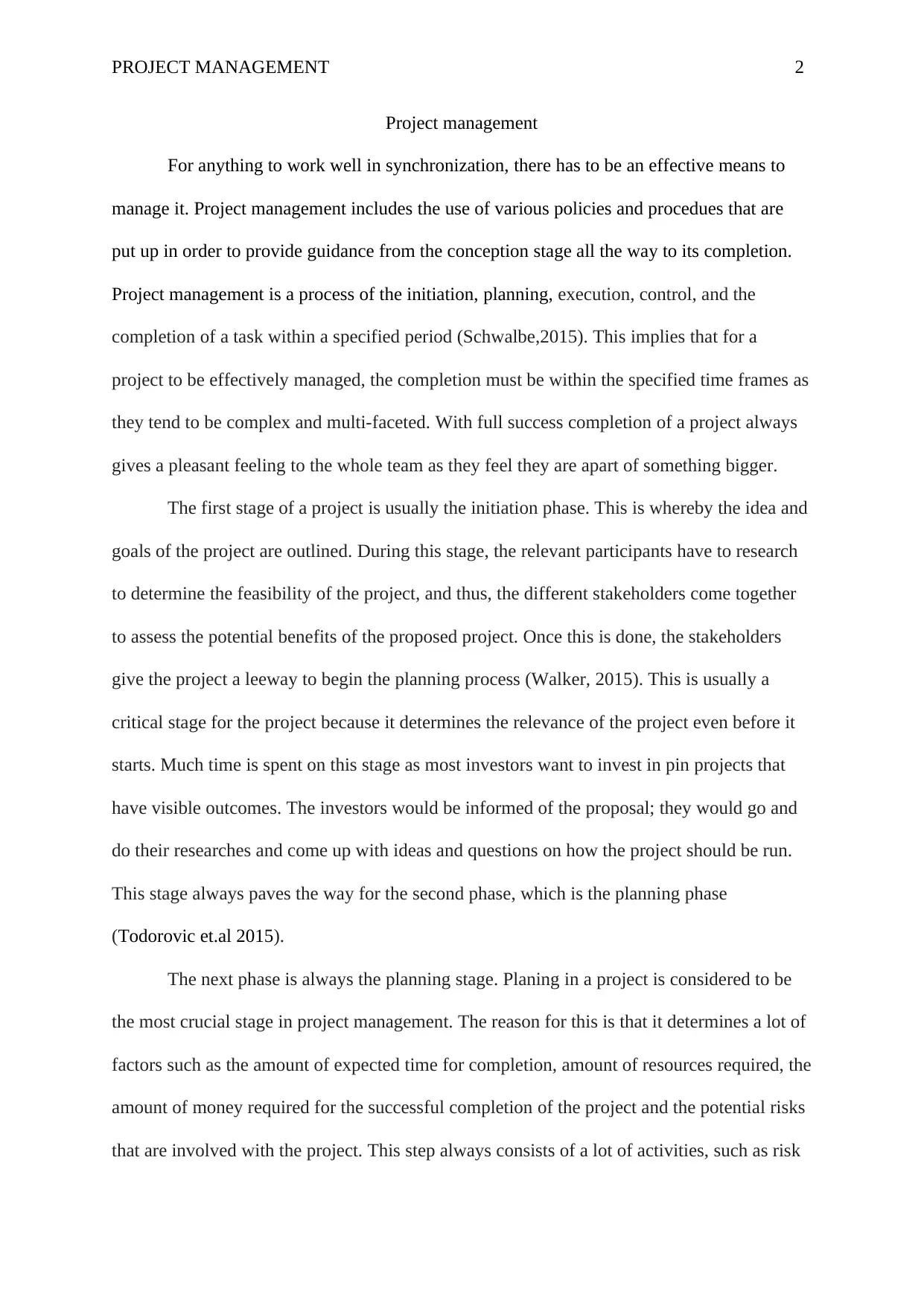
PROJECT MANAGEMENT 2
Project management
For anything to work well in synchronization, there has to be an effective means to
manage it. Project management includes the use of various policies and procedues that are
put up in order to provide guidance from the conception stage all the way to its completion.
Project management is a process of the initiation, planning, execution, control, and the
completion of a task within a specified period (Schwalbe,2015). This implies that for a
project to be effectively managed, the completion must be within the specified time frames as
they tend to be complex and multi-faceted. With full success completion of a project always
gives a pleasant feeling to the whole team as they feel they are apart of something bigger.
The first stage of a project is usually the initiation phase. This is whereby the idea and
goals of the project are outlined. During this stage, the relevant participants have to research
to determine the feasibility of the project, and thus, the different stakeholders come together
to assess the potential benefits of the proposed project. Once this is done, the stakeholders
give the project a leeway to begin the planning process (Walker, 2015). This is usually a
critical stage for the project because it determines the relevance of the project even before it
starts. Much time is spent on this stage as most investors want to invest in pin projects that
have visible outcomes. The investors would be informed of the proposal; they would go and
do their researches and come up with ideas and questions on how the project should be run.
This stage always paves the way for the second phase, which is the planning phase
(Todorovic et.al 2015).
The next phase is always the planning stage. Planing in a project is considered to be
the most crucial stage in project management. The reason for this is that it determines a lot of
factors such as the amount of expected time for completion, amount of resources required, the
amount of money required for the successful completion of the project and the potential risks
that are involved with the project. This step always consists of a lot of activities, such as risk
Project management
For anything to work well in synchronization, there has to be an effective means to
manage it. Project management includes the use of various policies and procedues that are
put up in order to provide guidance from the conception stage all the way to its completion.
Project management is a process of the initiation, planning, execution, control, and the
completion of a task within a specified period (Schwalbe,2015). This implies that for a
project to be effectively managed, the completion must be within the specified time frames as
they tend to be complex and multi-faceted. With full success completion of a project always
gives a pleasant feeling to the whole team as they feel they are apart of something bigger.
The first stage of a project is usually the initiation phase. This is whereby the idea and
goals of the project are outlined. During this stage, the relevant participants have to research
to determine the feasibility of the project, and thus, the different stakeholders come together
to assess the potential benefits of the proposed project. Once this is done, the stakeholders
give the project a leeway to begin the planning process (Walker, 2015). This is usually a
critical stage for the project because it determines the relevance of the project even before it
starts. Much time is spent on this stage as most investors want to invest in pin projects that
have visible outcomes. The investors would be informed of the proposal; they would go and
do their researches and come up with ideas and questions on how the project should be run.
This stage always paves the way for the second phase, which is the planning phase
(Todorovic et.al 2015).
The next phase is always the planning stage. Planing in a project is considered to be
the most crucial stage in project management. The reason for this is that it determines a lot of
factors such as the amount of expected time for completion, amount of resources required, the
amount of money required for the successful completion of the project and the potential risks
that are involved with the project. This step always consists of a lot of activities, such as risk
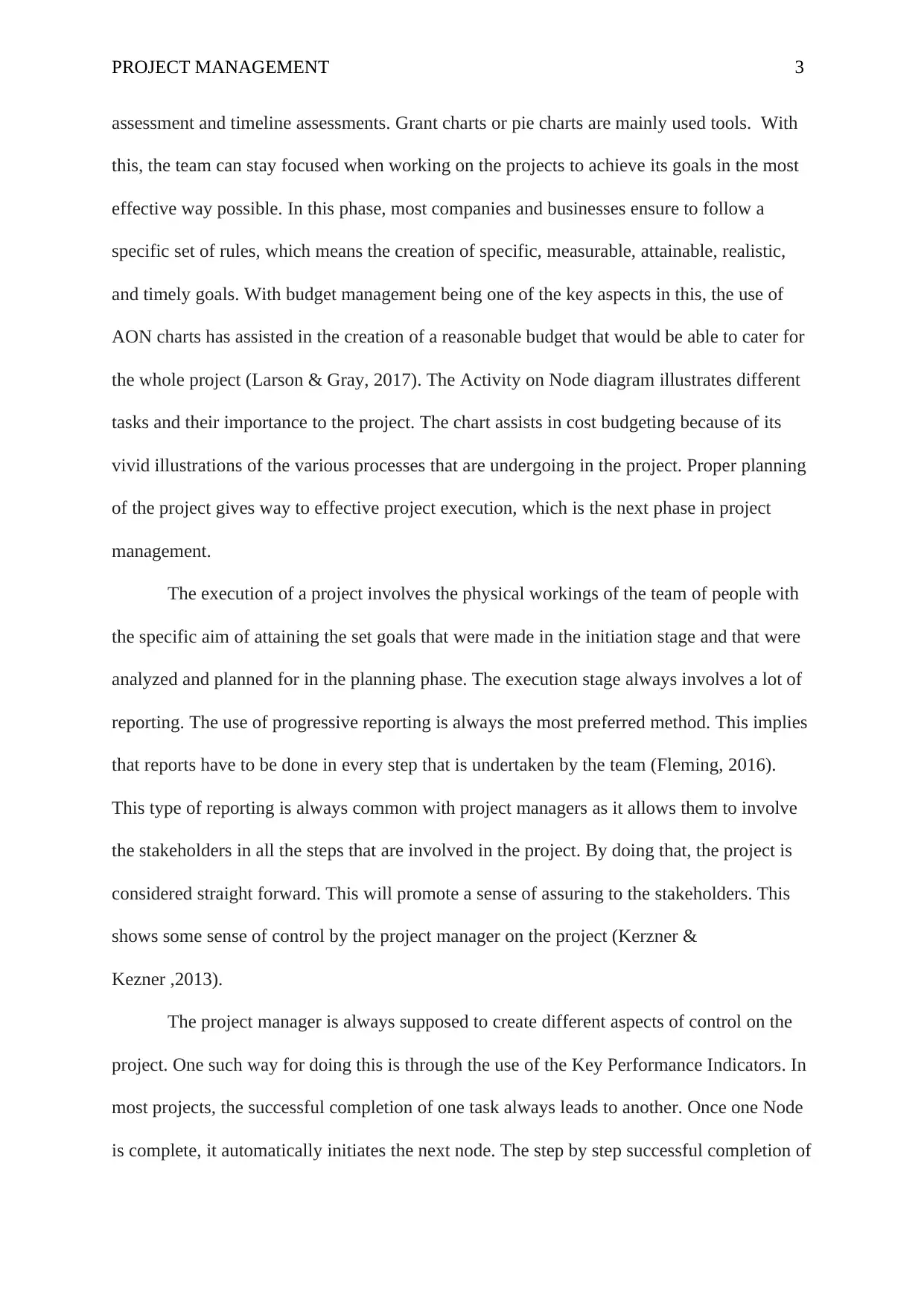
PROJECT MANAGEMENT 3
assessment and timeline assessments. Grant charts or pie charts are mainly used tools. With
this, the team can stay focused when working on the projects to achieve its goals in the most
effective way possible. In this phase, most companies and businesses ensure to follow a
specific set of rules, which means the creation of specific, measurable, attainable, realistic,
and timely goals. With budget management being one of the key aspects in this, the use of
AON charts has assisted in the creation of a reasonable budget that would be able to cater for
the whole project (Larson & Gray, 2017). The Activity on Node diagram illustrates different
tasks and their importance to the project. The chart assists in cost budgeting because of its
vivid illustrations of the various processes that are undergoing in the project. Proper planning
of the project gives way to effective project execution, which is the next phase in project
management.
The execution of a project involves the physical workings of the team of people with
the specific aim of attaining the set goals that were made in the initiation stage and that were
analyzed and planned for in the planning phase. The execution stage always involves a lot of
reporting. The use of progressive reporting is always the most preferred method. This implies
that reports have to be done in every step that is undertaken by the team (Fleming, 2016).
This type of reporting is always common with project managers as it allows them to involve
the stakeholders in all the steps that are involved in the project. By doing that, the project is
considered straight forward. This will promote a sense of assuring to the stakeholders. This
shows some sense of control by the project manager on the project (Kerzner &
Kezner ,2013).
The project manager is always supposed to create different aspects of control on the
project. One such way for doing this is through the use of the Key Performance Indicators. In
most projects, the successful completion of one task always leads to another. Once one Node
is complete, it automatically initiates the next node. The step by step successful completion of
assessment and timeline assessments. Grant charts or pie charts are mainly used tools. With
this, the team can stay focused when working on the projects to achieve its goals in the most
effective way possible. In this phase, most companies and businesses ensure to follow a
specific set of rules, which means the creation of specific, measurable, attainable, realistic,
and timely goals. With budget management being one of the key aspects in this, the use of
AON charts has assisted in the creation of a reasonable budget that would be able to cater for
the whole project (Larson & Gray, 2017). The Activity on Node diagram illustrates different
tasks and their importance to the project. The chart assists in cost budgeting because of its
vivid illustrations of the various processes that are undergoing in the project. Proper planning
of the project gives way to effective project execution, which is the next phase in project
management.
The execution of a project involves the physical workings of the team of people with
the specific aim of attaining the set goals that were made in the initiation stage and that were
analyzed and planned for in the planning phase. The execution stage always involves a lot of
reporting. The use of progressive reporting is always the most preferred method. This implies
that reports have to be done in every step that is undertaken by the team (Fleming, 2016).
This type of reporting is always common with project managers as it allows them to involve
the stakeholders in all the steps that are involved in the project. By doing that, the project is
considered straight forward. This will promote a sense of assuring to the stakeholders. This
shows some sense of control by the project manager on the project (Kerzner &
Kezner ,2013).
The project manager is always supposed to create different aspects of control on the
project. One such way for doing this is through the use of the Key Performance Indicators. In
most projects, the successful completion of one task always leads to another. Once one Node
is complete, it automatically initiates the next node. The step by step successful completion of
⊘ This is a preview!⊘
Do you want full access?
Subscribe today to unlock all pages.

Trusted by 1+ million students worldwide
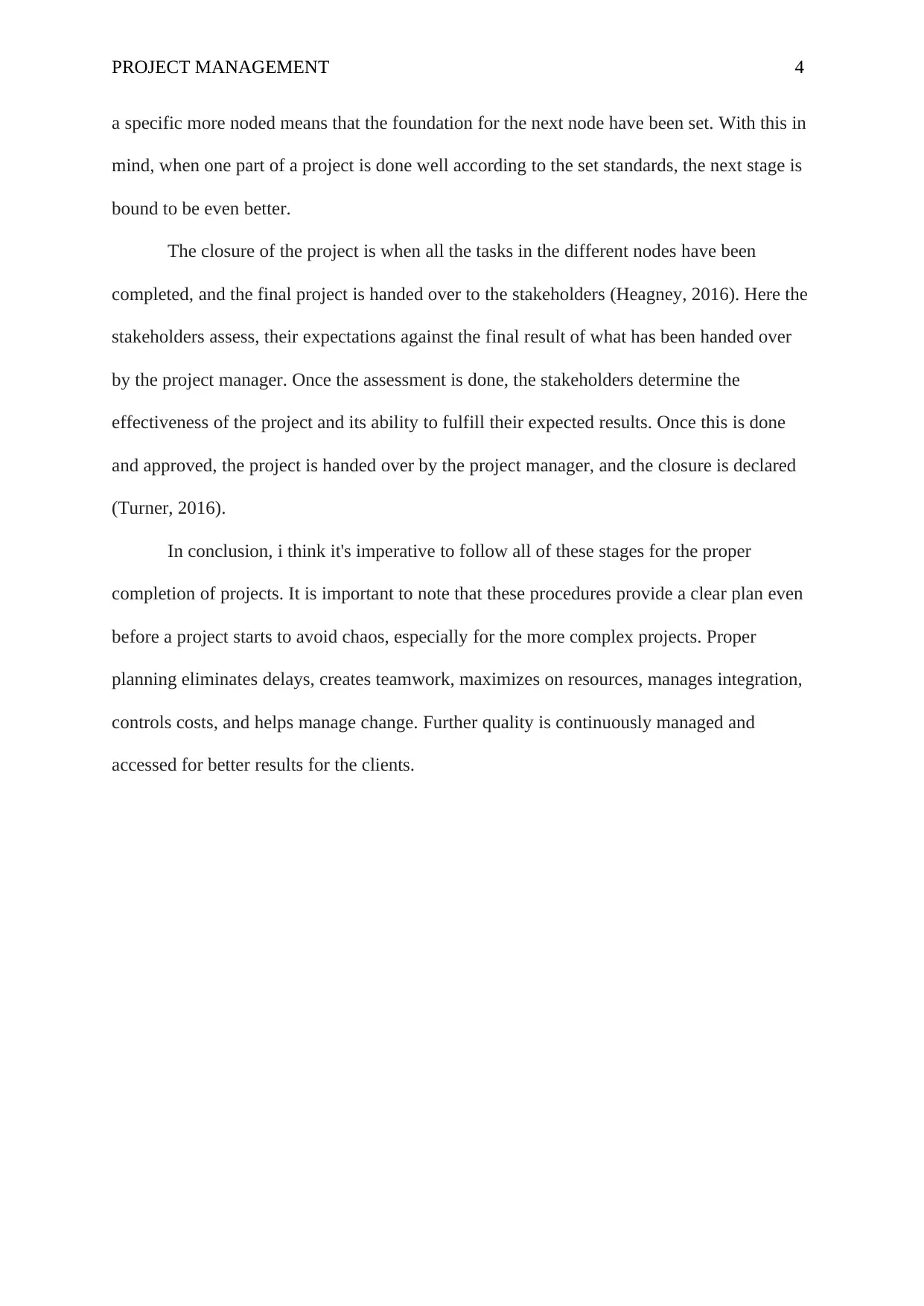
PROJECT MANAGEMENT 4
a specific more noded means that the foundation for the next node have been set. With this in
mind, when one part of a project is done well according to the set standards, the next stage is
bound to be even better.
The closure of the project is when all the tasks in the different nodes have been
completed, and the final project is handed over to the stakeholders (Heagney, 2016). Here the
stakeholders assess, their expectations against the final result of what has been handed over
by the project manager. Once the assessment is done, the stakeholders determine the
effectiveness of the project and its ability to fulfill their expected results. Once this is done
and approved, the project is handed over by the project manager, and the closure is declared
(Turner, 2016).
In conclusion, i think it's imperative to follow all of these stages for the proper
completion of projects. It is important to note that these procedures provide a clear plan even
before a project starts to avoid chaos, especially for the more complex projects. Proper
planning eliminates delays, creates teamwork, maximizes on resources, manages integration,
controls costs, and helps manage change. Further quality is continuously managed and
accessed for better results for the clients.
a specific more noded means that the foundation for the next node have been set. With this in
mind, when one part of a project is done well according to the set standards, the next stage is
bound to be even better.
The closure of the project is when all the tasks in the different nodes have been
completed, and the final project is handed over to the stakeholders (Heagney, 2016). Here the
stakeholders assess, their expectations against the final result of what has been handed over
by the project manager. Once the assessment is done, the stakeholders determine the
effectiveness of the project and its ability to fulfill their expected results. Once this is done
and approved, the project is handed over by the project manager, and the closure is declared
(Turner, 2016).
In conclusion, i think it's imperative to follow all of these stages for the proper
completion of projects. It is important to note that these procedures provide a clear plan even
before a project starts to avoid chaos, especially for the more complex projects. Proper
planning eliminates delays, creates teamwork, maximizes on resources, manages integration,
controls costs, and helps manage change. Further quality is continuously managed and
accessed for better results for the clients.
Paraphrase This Document
Need a fresh take? Get an instant paraphrase of this document with our AI Paraphraser
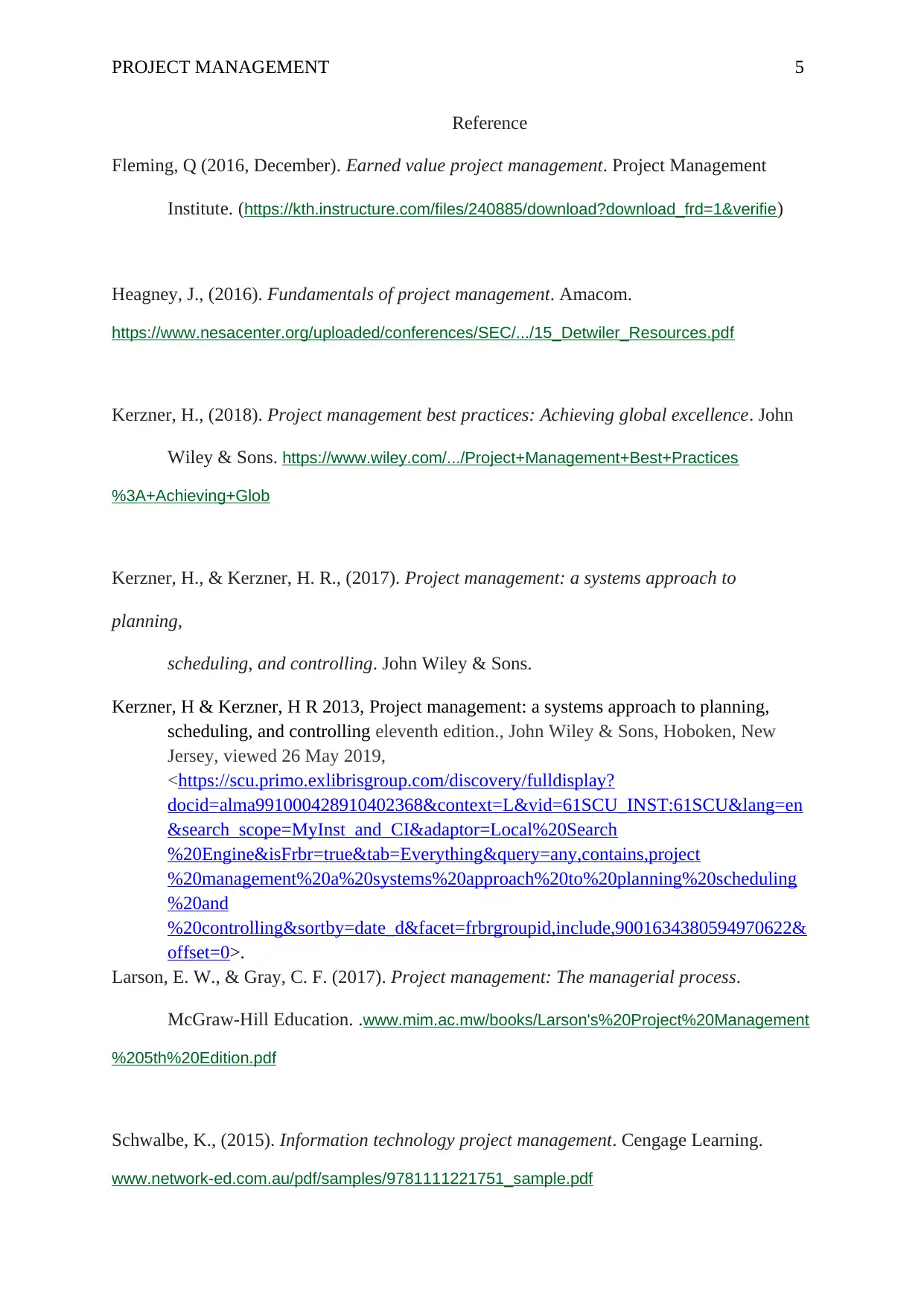
PROJECT MANAGEMENT 5
Reference
Fleming, Q (2016, December). Earned value project management. Project Management
Institute. (https://kth.instructure.com/files/240885/download?download_frd=1&verifie)
Heagney, J., (2016). Fundamentals of project management. Amacom.
https://www.nesacenter.org/uploaded/conferences/SEC/.../15_Detwiler_Resources.pdf
Kerzner, H., (2018). Project management best practices: Achieving global excellence. John
Wiley & Sons. https://www.wiley.com/.../Project+Management+Best+Practices
%3A+Achieving+Glob
Kerzner, H., & Kerzner, H. R., (2017). Project management: a systems approach to
planning,
scheduling, and controlling. John Wiley & Sons.
Kerzner, H & Kerzner, H R 2013, Project management: a systems approach to planning,
scheduling, and controlling eleventh edition., John Wiley & Sons, Hoboken, New
Jersey, viewed 26 May 2019,
<https://scu.primo.exlibrisgroup.com/discovery/fulldisplay?
docid=alma991000428910402368&context=L&vid=61SCU_INST:61SCU&lang=en
&search_scope=MyInst_and_CI&adaptor=Local%20Search
%20Engine&isFrbr=true&tab=Everything&query=any,contains,project
%20management%20a%20systems%20approach%20to%20planning%20scheduling
%20and
%20controlling&sortby=date_d&facet=frbrgroupid,include,9001634380594970622&
offset=0>.
Larson, E. W., & Gray, C. F. (2017). Project management: The managerial process.
McGraw-Hill Education. .www.mim.ac.mw/books/Larson's%20Project%20Management
%205th%20Edition.pdf
Schwalbe, K., (2015). Information technology project management. Cengage Learning.
www.network-ed.com.au/pdf/samples/9781111221751_sample.pdf
Reference
Fleming, Q (2016, December). Earned value project management. Project Management
Institute. (https://kth.instructure.com/files/240885/download?download_frd=1&verifie)
Heagney, J., (2016). Fundamentals of project management. Amacom.
https://www.nesacenter.org/uploaded/conferences/SEC/.../15_Detwiler_Resources.pdf
Kerzner, H., (2018). Project management best practices: Achieving global excellence. John
Wiley & Sons. https://www.wiley.com/.../Project+Management+Best+Practices
%3A+Achieving+Glob
Kerzner, H., & Kerzner, H. R., (2017). Project management: a systems approach to
planning,
scheduling, and controlling. John Wiley & Sons.
Kerzner, H & Kerzner, H R 2013, Project management: a systems approach to planning,
scheduling, and controlling eleventh edition., John Wiley & Sons, Hoboken, New
Jersey, viewed 26 May 2019,
<https://scu.primo.exlibrisgroup.com/discovery/fulldisplay?
docid=alma991000428910402368&context=L&vid=61SCU_INST:61SCU&lang=en
&search_scope=MyInst_and_CI&adaptor=Local%20Search
%20Engine&isFrbr=true&tab=Everything&query=any,contains,project
%20management%20a%20systems%20approach%20to%20planning%20scheduling
%20and
%20controlling&sortby=date_d&facet=frbrgroupid,include,9001634380594970622&
offset=0>.
Larson, E. W., & Gray, C. F. (2017). Project management: The managerial process.
McGraw-Hill Education. .www.mim.ac.mw/books/Larson's%20Project%20Management
%205th%20Edition.pdf
Schwalbe, K., (2015). Information technology project management. Cengage Learning.
www.network-ed.com.au/pdf/samples/9781111221751_sample.pdf
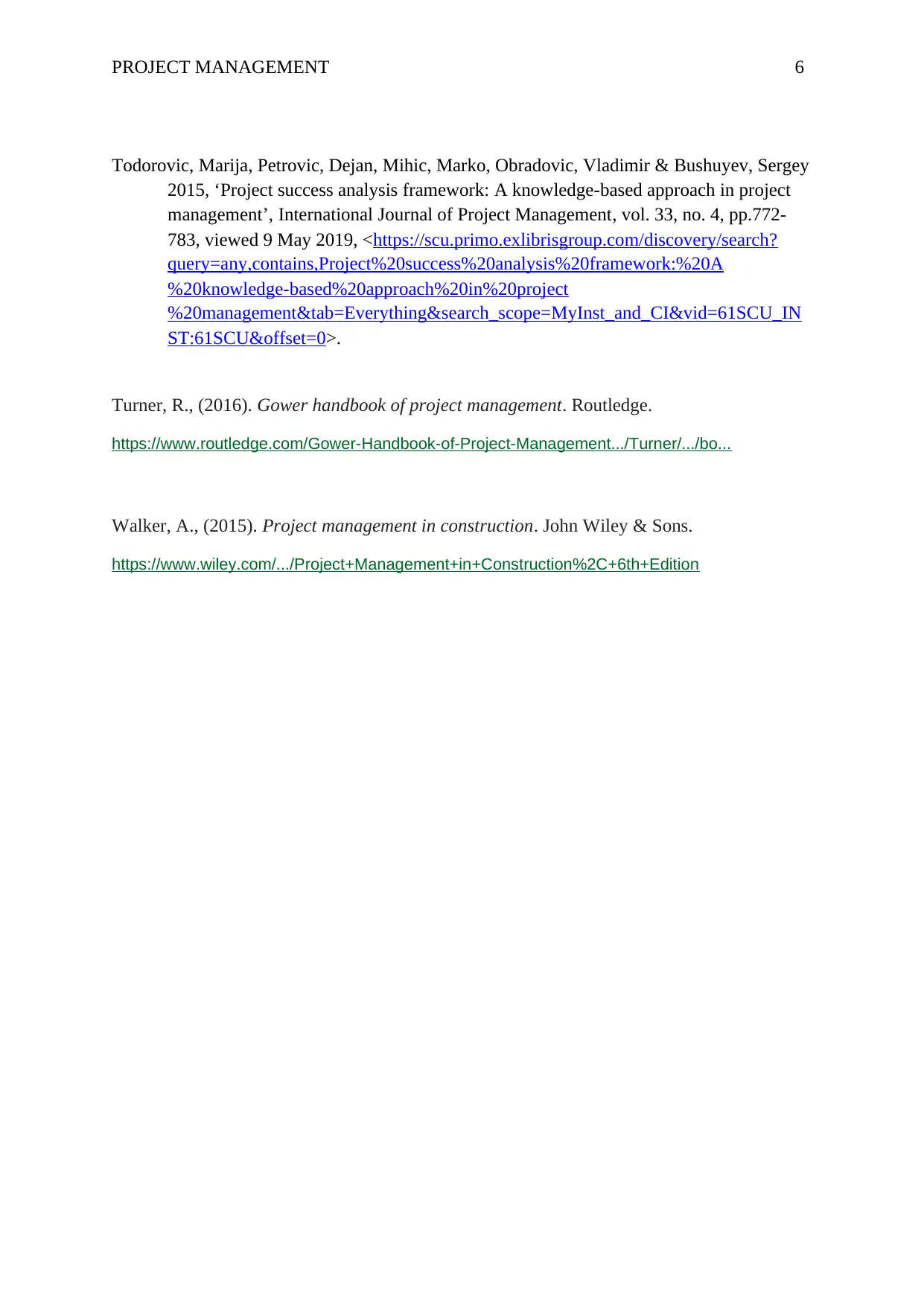
PROJECT MANAGEMENT 6
Todorovic, Marija, Petrovic, Dejan, Mihic, Marko, Obradovic, Vladimir & Bushuyev, Sergey
2015, ‘Project success analysis framework: A knowledge-based approach in project
management’, International Journal of Project Management, vol. 33, no. 4, pp.772-
783, viewed 9 May 2019, <https://scu.primo.exlibrisgroup.com/discovery/search?
query=any,contains,Project%20success%20analysis%20framework:%20A
%20knowledge-based%20approach%20in%20project
%20management&tab=Everything&search_scope=MyInst_and_CI&vid=61SCU_IN
ST:61SCU&offset=0>.
Turner, R., (2016). Gower handbook of project management. Routledge.
https://www.routledge.com/Gower-Handbook-of-Project-Management.../Turner/.../bo...
Walker, A., (2015). Project management in construction. John Wiley & Sons.
https://www.wiley.com/.../Project+Management+in+Construction%2C+6th+Edition
Todorovic, Marija, Petrovic, Dejan, Mihic, Marko, Obradovic, Vladimir & Bushuyev, Sergey
2015, ‘Project success analysis framework: A knowledge-based approach in project
management’, International Journal of Project Management, vol. 33, no. 4, pp.772-
783, viewed 9 May 2019, <https://scu.primo.exlibrisgroup.com/discovery/search?
query=any,contains,Project%20success%20analysis%20framework:%20A
%20knowledge-based%20approach%20in%20project
%20management&tab=Everything&search_scope=MyInst_and_CI&vid=61SCU_IN
ST:61SCU&offset=0>.
Turner, R., (2016). Gower handbook of project management. Routledge.
https://www.routledge.com/Gower-Handbook-of-Project-Management.../Turner/.../bo...
Walker, A., (2015). Project management in construction. John Wiley & Sons.
https://www.wiley.com/.../Project+Management+in+Construction%2C+6th+Edition
⊘ This is a preview!⊘
Do you want full access?
Subscribe today to unlock all pages.

Trusted by 1+ million students worldwide
1 out of 6
Related Documents
Your All-in-One AI-Powered Toolkit for Academic Success.
+13062052269
info@desklib.com
Available 24*7 on WhatsApp / Email
![[object Object]](/_next/static/media/star-bottom.7253800d.svg)
Unlock your academic potential
Copyright © 2020–2025 A2Z Services. All Rights Reserved. Developed and managed by ZUCOL.





